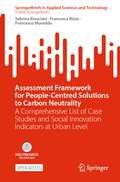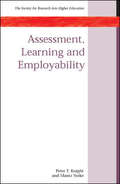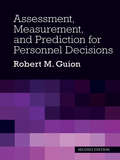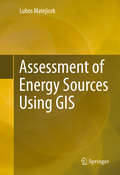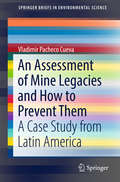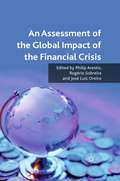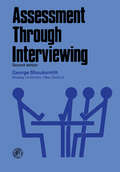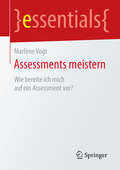- Table View
- List View
Assessment Centres and Global Talent Management
by George C. IiiGlobalization, innovation, market share, identifying visionary leaders and, particularly, talent management ...are just some of the issues that benefit from using assessment and development centres. Assessment Centres and Global Talent Management focuses on topics that influence the design of the assessment centre in terms of the competencies being assessed, the exercises that are used and the nature of the event, so that they can deliver what is required; often to change organizational culture and values. Practical examples and case studies are sprinkled throughout the book as international contributors explore cross-cultural implications, and consider how the design, development and use of assessment centres should be adapted to different cultures. Some of the world's leading researchers and practitioners outline their research into new applications for assessment centre methods, showing how they have used it to design and implement specific assessment and development centres. This is a book from which practitioners can see how science informs good practice, and scholars will find the 32 chapters a rich source of ideas for conducting research into emerging issues in the field.
Assessment Framework for People-Centred Solutions to Carbon Neutrality: A Comprehensive List of Case Studies and Social Innovation Indicators at Urban Level (SpringerBriefs in Applied Sciences and Technology)
by Sabrina Bresciani Francesca Rizzo Francesco MuredduThis open access book presents a catalogue of over one thousand indicators which can be used by cities' public administrators to monitor and evaluate social innovation action plans to support people-centred, collaborative or co-designed solutions to lower carbon emissions. Indicators are clustered according to a framework of social innovation solutions for climate neutrality at city level, developed by merging top-down academic knowledge with bottom-up pragmatic case studies. There is currently limited guidance on how to embed social innovations in their cities’ action plans with the aim of reaching climate neutrality, and on how to assess the progress and impacts of such people-centred projects in cities. The book addresses this gap and is thus relevant for scholars in the field of policy-making and design, as well as cities’ transition teams, policymakers and consultants. Based on the work developed within the EU-funded project NetZeroCities, intervention logics are provided for each of the ten categories of action, with related indicators clustered by category and evaluation criteria (effectiveness, efficiency, relevance, replicability, and scalability). Guidelines to implement the framework support city administrators in defining steps they need to follow to apply the indicators to their local case, making social innovation a crucial lever for accelerating systemic transformation.
Assessment Learning and Employability (UK Higher Education OUP Humanities & Social Sciences Higher Education OUP)
by Peter Knight Mantz YorkeWhat is assessed gets attention: what is not assessed does not. When higher education is expected to promote complex achievements in subject disciplines and in terms of 'employability', problems arise: how are such achievements to be assessed? In the first part of the book, it is argued that existing grading practices cannot cope with the expectations laid upon them, while the potential of formative assessment for the support of learning is not fully realised. The authors argue that improving the effectiveness of assessment depends on a well-grounded appreciation of what assessment is, and what may and may not be expected of it. The second part covers summative judgements for high-stakes purposes. Using established measurement theory, a view is developed of the conditions under which affordable, useful, valid and reliable summative judgements can be made. One conclusion is that many complex achievements resist high-stakes assessment, which directs attention to low-stakes, essentially formative, alternatives. Assessment for learning and employability demands more than module-level changes to assessment methods. The final part discusses how institutions need to respond in policy terms to the challenges that have been posed. The book concludes with a discussion of how institutions can respond in policy terms to the challenges that have been posed.Assessment, Learning and Employability has wide and practical relevance - to teachers, module and programme leaders, higher education managers and quality enhancement specialists.
Assessment, Measurement, and Prediction for Personnel Decisions
by Robert M. GuionRobert Guion’s best seller is now available in this new second edition. This noted book offers a comprehensive and practical view of assessment –based personnel decisions not available elsewhere in a single source. This edition more frankly evaluates the current research and practice and presents challenges that will change the basic thinking about staffing systems. This new edition suggests new directions for research and practice, includes emphasis on modern computers and technology useful in assessment, and pays more attention to prediction of individual growth and globalization challenges in the assessment process. The book will be of interest to faculty and students in Industrial Organizational psychology, human resource management and business. IO psychologists in private business and public sector organizations who have responsibilities for staffing and an interest in measurement and statistics will find this book useful.
Assessment, Measurement, and Prediction for Personnel Decisions
by Robert M. GuionRobert Guion’s best seller is now available in this new second edition. This noted book offers a comprehensive and practical view of assessment –based personnel decisions not available elsewhere in a single source. This edition more frankly evaluates the current research and practice and presents challenges that will change the basic thinking about staffing systems. This new edition suggests new directions for research and practice, includes emphasis on modern computers and technology useful in assessment, and pays more attention to prediction of individual growth and globalization challenges in the assessment process. The book will be of interest to faculty and students in Industrial Organizational psychology, human resource management and business. IO psychologists in private business and public sector organizations who have responsibilities for staffing and an interest in measurement and statistics will find this book useful.
Assessment of Accessibility, Use Behavior, and Equity of Parks in a Compact City: Insights from Singapore (Urban Sustainability)
by Jingyuan ZhangThis book presents methodological and empirical advancements in evaluating the accessibility, use demand and behavior, and equity of urban parks. A comparative analysis was conducted across four planning areas in Singapore, a renowned compact city. An innovated conceptual framework was devised to effectively measure residents’ physical and perceived accessibility to their most often visited parks, explore their perceptional park use demand and behavior, as well as to evaluate the spatial equity of park distribution. This was achieved through spatial analysis combined with a household perception study involving 597 participants. The target audience for this book includes undergraduate and graduate students interested in accessibility, behavior and equity analysis, researchers focusing on spatial and behavioral analysis of urban public facilities, and practitioners involved in the planning and management of urban parks and greenspaces.
Assessment of Accounting Evaluation Practices: A Research-Based Review of Turkey and Romania (Contributions to Finance and Accounting)
by Ibrahim MertThe book describes the historical evolution and development of accounting theories and principles. Value and valuation have been reviewed extensively. The author provides a detailed comparison between historic and fair value accounting. A comprehensive review of the literature and researchers’ opinions about measurement, fair value, and historical cost value will enable the readers to understand the concepts in detail. Additionally, the book includes case studies evaluating the accounting practices in Turkey and Romania to illustrate how these concepts are implemented in practice. The reader will obtain a good understanding of the local nationalized accounting systems, and up to what extent countries have adapted to IFRS. The books discusses the usage of IT tools in accounting and analyses the impact of information technology such as big data, artificial intelligence, and data analytics in the field of accounting.
Assessment of Carbon Footprint in Different Industrial Sectors, Volume 1 (EcoProduction)
by Subramanian Senthilkannan MuthuCarbon footprint is one of the important environmental impacts, which has received greater attention from the public, government and media. It is one of the important topics of even any government’s agenda as well and every nation is trying its best to reduce its carbon footprint to the maximum possible extent. Every company would like to reduce the carbon footprint of its products and consumers are looking for the products which emit lower carbon emissions in their entire life cycle. Assessment of Carbon footprint for different products, processes and services and also carbon labelling of products have become familiar topics in the recent past in various industrial sectors. Every industry has its unique assessment and modelling techniques, allocation procedures, mitigation methods and labelling strategies for its carbon emissions. With this background, this book has been framed with dedicated chapters on carbon footprint assessment on various industrial sectors. In each chapter, details pertaining to the assessment methodologies of carbon footprint followed in a particular industry, challenges in calculating the carbon footprint, case studies of various products in that particular industry, mitigation measures to be followed to trim down the carbon footprint, recommendations for further research are discussed in detail. This first volume includes the carbon footprint assessment methodology of agricultural sector, telecommunication sector, food sector, ceramic industry, packaging industry, building and construction sector and solid waste sector.
Assessment of Carbon Footprint in Different Industrial Sectors, Volume 2 (EcoProduction)
by Subramanian Senthilkannan MuthuFollowed by the previous part (Volume-1), Volume-2 of carbon footprint assessment book deals with the assessment of carbon footprint in different other sectors, which were not dealt in the first part. Attention on Carbon footprint is growing day-by-day from the public, government and media. Certainly it is one of the most important topics in the agenda of every nation, which is trying its best to reduce its carbon footprint to the maximum possible extent. Every manufacturing industry or sector would like to reduce the carbon footprint of its products and consumers are looking for the products which emit lower carbon emissions in their entire life cycle. Assessment of Carbon footprint for different products, processes and services and also carbon labeling of products have become familiar topics in the recent past in various industrial sectors. Every industry has its unique assessment and modeling techniques, allocation procedures, mitigation methods and labeling strategies for its carbon emissions. With this background, volume two of this book has been framed with dedicated chapters on carbon footprint assessment on various industrial sectors, apart from the ones covered in Volume 1. In each chapter, details pertaining to the assessment methodologies of carbon footprint followed in a particular industry, challenges in calculating the carbon footprint, case studies of various products in that particular industry, mitigation measures to be followed to trim down the carbon footprint, recommendations for further research are discussed in detail.
Assessment of Energy Sources Using GIS
by Lubos MatejicekThis volume is a comprehensive guide to the use of geographic information systems (GIS) for the spatial analysis of supply and demand for energy in the global and local scale. It gathers the latest research and techniques in GIS for spatial and temporal analysis of energy systems, mapping of energy from fossil fuels, optimization of renewable energy sources, optimized deployment of existing power sources, and assessment of environmental impact of all of the above. Author Lubos Matejicek covers GIS for assessment a wide variety of energy sources, including fossil fuels, hydropower, wind power, solar energy, biomass energy, and nuclear power as well as the use of batteries and accumulators. The author also utilizes case studies to illustrate advanced techniques such as multicriteria analysis, environmental modeling for prediction of energy consumption, and the use of mobile computing and multimedia tools.
Assessment of Environmental Impact by Grocery Shopping Bags: An Eco-Functional Approach (EcoProduction)
by Subramanian Senthilkannan Muthu Yi LiThis book reviews the manufacturing processes of different shopping bags used for grocery purposes, life cycle impacts, modelling of life cycle impacts, carbon and eco-footprints in different countries, consumption of shopping bags in different countries, consumer behaviour of shopping bags in various countries and its relation to eco-impact, assessment of functionality of shopping bags, concept and framework of eco-functional assessment of shopping bags, biodegradation of shopping bags, etc.
Assessment of Hydrogen Energy for Sustainable Development (NATO Science for Peace and Security Series C: Environmental Security)
by John W. Sheffield Çigdem SheffieldFossil fuel prices continue to rise and, at the same time, environmental policies are demanding a reduction in greenhouse gases and toxic emissions. A coherent energy strategy is needed: one that addresses both energy supply and demand and takes into account the whole energy lifecycle, from fuel production to the end-users of energy systems. This book examines hydrogen energy technologies and infrastructure development.
An Assessment of Mine Legacies and How to Prevent Them: A Case Study from Latin America (SpringerBriefs in Environmental Science)
by Vladimir Pacheco CuevaThis book seeks to enrich the growing literature on mine legacies by examining a case study of a small abandoned mine in Latin America. Using a combination of Rapid Rural Appraisal and secondary source analysis, this study assessed some of the most damaging legacies of the San Sebastian mine in eastern El Salvador, compared the country’s mine closure legislation against world’s best practice standards and provided strategies for awareness, prevention and remediation. The most damaging legacy to the environment is that of Acid Mine Drainage (AMD) contamination of the local river. The impact of AMD is felt well beyond the mining district and the costs of prevention and remediation were found to be significant. Apart from environmental legacies, the mine also left a number of socio-economic legacies including: limited access to non-polluted water that results in San Sebastian residents devoting a high proportion of their income in obtaining water, lost opportunities due to the cessation of mining, uncertain land tenure situation and increasing growth of ASGM activities that exacerbate already existing environmental pollution due to use of mercury. The study also found that the state’s capacity to ensure compliance with the law is very weak and that in many important respects the country’s current legal framework does not meet world’s best practice when it comes to mine closure requirements.The findings are important because they demonstrate that the lack of closure planning can lead to private operators socializing the costs of pollution. The study also shows that the lack of state capacity may result in extractive projects becoming socio-economic liabilities in the long term.
Assessment of Power System Reliability: Methods and Applications
by Marko ČepinThe importance of power system reliability is demonstrated when our electricity supply is disrupted, whether it decreases the comfort of our free time at home or causes the shutdown of our companies and results in huge economic deficits. The objective of Assessment of Power System Reliability is to contribute to the improvement of power system reliability. It consists of six parts divided into twenty chapters. The first part introduces the important background issues that affect power system reliability. The second part presents the reliability methods that are used for analyses of technical systems and processes. The third part discusses power flow analysis methods, because the dynamic aspect of a power system is an important part of related reliability assessments. The fourth part explores various aspects of the reliability assessment of power systems and their parts. The fifth part covers optimization methods. The sixth part looks at the application of reliability and optimization methods.Assessment of Power System Reliability has been written in straightforward language that continues into the mathematical representation of the methods. Power engineers and developers will appreciate the emphasis on practical usage, while researchers and advanced students will benefit from the simple examples that can facilitate their understanding of the theory behind power system reliability and that outline the procedure for application of the presented methods.
An Assessment of the Global Impact of the Financial Crisis
by Philip Arestis, Rogéo Sobreira & Joséuis OreiroThis topical volume analyzes the impact of the 2008 financial crisis. It considers the origins and explanations of the current crisis, examines the regulatory implications and, with specific focus on developing countries, it provides a strategy for economic growth that can guarantee financial stability in the future.
Assessment Strategies for Knowledge Organizations (Working Methods for Knowledge Management)
by Dean Testa Johel Brown-Grant Denise BedfordAssessment models and methods are taught in business schools, routinely published, conducted at all organizational levels and widely understood. Yet as organizations transform from an industrial to knowledge-based economy, assessments are rarely adapted to the new environment. Simply applying existing assessment models and methods to knowledge does not address the challenge. Knowledge assets, knowledge transactions and knowledge capabilities have unique properties and behaviors that may render traditional methods as unreliable or invalid. Expert authors Dean Testa, Johel Brown-Grant and Denise Bedford draw from their practical and theoretical experience in designing assessments for knowledge organizations, from observing successes and failures in a variety of organizations. Synthesizing their experience, their discussions here help knowledge management professionals gain a deeper understanding of maturity models and determine how best to create an assessment strategy for their organization. Offering an enhanced understanding of how to engage organisations in assessments, describing maturity factors and offering tools to communicate the results of these maturity assessments, this is an unmissable book for knowledge management professionals and researchers.
Assessment Strategies for Knowledge Organizations (Working Methods for Knowledge Management)
by Dean Testa Johel Brown-Grant Denise BedfordAssessment models and methods are taught in business schools, routinely published, conducted at all organizational levels and widely understood. Yet as organizations transform from an industrial to knowledge-based economy, assessments are rarely adapted to the new environment. Simply applying existing assessment models and methods to knowledge does not address the challenge. Knowledge assets, knowledge transactions and knowledge capabilities have unique properties and behaviors that may render traditional methods as unreliable or invalid. Expert authors Dean Testa, Johel Brown-Grant and Denise Bedford draw from their practical and theoretical experience in designing assessments for knowledge organizations, from observing successes and failures in a variety of organizations. Synthesizing their experience, their discussions here help knowledge management professionals gain a deeper understanding of maturity models and determine how best to create an assessment strategy for their organization. Offering an enhanced understanding of how to engage organisations in assessments, describing maturity factors and offering tools to communicate the results of these maturity assessments, this is an unmissable book for knowledge management professionals and researchers.
Assessment Through Interviewing
by G. ShouksmithThis edition retains much of the material of the first edition, but includes extended material on planning for the interview, and on the conduct of the interview, aimed at making its coverage of the basic concepts more comprehensive. Use of groups for individual assessment and development, particularly in human relations training contexts, has increased immeasurably in the last decade, and this has necessitated a more extensive treatment of the theory and practice of group dynamics; the use of counselling interviews receives more attention in this edition, in recognition of recent advances in the use of the interview therapeutically
Assessments meistern: Wie bereite ich mich auf ein Assessment vor? (essentials)
by Marlène VogtDieses Essential zeigt Ihnen, was Sie in einem Assessment erwartet und wie Sie sich darauf vorbereiten können. Zu diesem Zweck wird dargestellt, wie ein Assessment typischerweise aufgebaut ist, mit welchen Aufgaben und Übungen Sie konfrontiert sein werden und wie Sie diese am besten meistern können. Darüber hinaus erhalten Sie Anregungen, wie Sie mithilfe von klaren Zielformulierungen und einer „bewussten Haltung“ während des Assessments Ihr Bestes geben und Ihre Kompetenzen unter Beweis stellen können.
Asset Allocation: From Theory to Practice and Beyond
by William Kinlaw Mark P. Kritzman David TurkingtonDiscover a masterful exploration of the fallacies and challenges of asset allocation In Asset Allocation: From Theory to Practice and Beyond—the newly and substantially revised Second Edition of A Practitioner’s Guide to Asset Allocation—accomplished finance professionals William Kinlaw, Mark P. Kritzman, and David Turkington deliver a robust and insightful exploration of the core tenets of asset allocation. Drawing on their experience working with hundreds of the world’s largest and most sophisticated investors, the authors review foundational concepts, debunk fallacies, and address cutting-edge themes like factor investing and scenario analysis. The new edition also includes references to related topics at the end of each chapter and a summary of key takeaways to help readers rapidly locate material of interest. The book also incorporates discussions of: The characteristics that define an asset class, including stability, investability, and similarity The fundamentals of asset allocation, including definitions of expected return, portfolio risk, and diversification Advanced topics like factor investing, asymmetric diversification, fat tails, long-term investing, and enhanced scenario analysis as well as tools to address challenges such as liquidity, rebalancing, constraints, and within-horizon risk. Perfect for client-facing practitioners as well as scholars who seek to understand practical techniques, Asset Allocation: From Theory to Practice and Beyond is a must-read resource from an author team of distinguished finance experts and a forward by Nobel prize winner Harry Markowitz.
Asset Allocation: From Theory to Practice and Beyond (Wiley Finance Ser.)
by William Kinlaw Mark P. Kritzman David TurkingtonDiscover a masterful exploration of the fallacies and challenges of asset allocation In Asset Allocation: From Theory to Practice and Beyond—the newly and substantially revised Second Edition of A Practitioner’s Guide to Asset Allocation—accomplished finance professionals William Kinlaw, Mark P. Kritzman, and David Turkington deliver a robust and insightful exploration of the core tenets of asset allocation. Drawing on their experience working with hundreds of the world’s largest and most sophisticated investors, the authors review foundational concepts, debunk fallacies, and address cutting-edge themes like factor investing and scenario analysis. The new edition also includes references to related topics at the end of each chapter and a summary of key takeaways to help readers rapidly locate material of interest. The book also incorporates discussions of: The characteristics that define an asset class, including stability, investability, and similarity The fundamentals of asset allocation, including definitions of expected return, portfolio risk, and diversification Advanced topics like factor investing, asymmetric diversification, fat tails, long-term investing, and enhanced scenario analysis as well as tools to address challenges such as liquidity, rebalancing, constraints, and within-horizon risk. Perfect for client-facing practitioners as well as scholars who seek to understand practical techniques, Asset Allocation: From Theory to Practice and Beyond is a must-read resource from an author team of distinguished finance experts and a forward by Nobel prize winner Harry Markowitz.
Asset Allocation and International Investments (Finance and Capital Markets Series)
by G. GregoriouThis book relates to strategic asset allocation for institutional investors. It consists of a collection of edited papers from academics worldwide on the latest developments in asset allocation, portfolio management and international investments. These expert studies can improve the risk and return characteristics of your investment portfolio.
Asset Allocation and Private Markets: A Guide to Investing with Private Equity, Private Debt, and Private Real Assets (Wiley Finance)
by Cyril Demaria Maurice Pedergnana Remy He Roger Rissi Sarah DebrandThe comprehensive guide to private market asset allocation Asset Allocation and Private Markets provides institutional investors, such as pension funds, insurance groups and family offices, with a single-volume authoritative resource on including private markets in strategic asset allocation. Written by four academic and practitioner specialists, this book provides the background knowledge investors need, coupled with practical advice from experts in the field. The discussion focuses on private equity, private debt and private real assets, and their correlation with other asset classes to establish optimized investment portfolios. Armed with the grounded and critical perspectives provided in this book, investors can tailor their portfolio and effectively allocate assets to traditional and private markets in their best interest. In-depth discussion of return, risks, liquidity and other factors of asset allocation takes a more practical turn with guidance on allocation construction and capital deployment, the “endowment model,” and hedging — or lack thereof. Unique in the depth and breadth of information on this increasingly attractive asset class, this book is an invaluable resource for investors seeking new strategies. Discover alternative solutions to traditional asset allocation strategies Consider attractive returns of private markets Delve into private equity, private debt and private real assets Gain expert perspectives on correlation, risk, liquidity, and portfolio construction Private markets represent a substantial proportion of global wealth. Amidst disappointing returns from stocks and bonds, investors are increasingly looking to revitalise traditional asset allocation strategies by weighting private market structures more heavily in their portfolios. Pension fund and other long-term asset managers need deeper information than is typically provided in tangential reference in broader asset allocation literature; Asset Allocation and Private Markets fills the gap, with comprehensive information and practical guidance.
Asset Allocation and Private Markets: A Guide to Investing with Private Equity, Private Debt, and Private Real Assets (Wiley Finance)
by Cyril Demaria Maurice Pedergnana Remy He Roger Rissi Sarah DebrandThe comprehensive guide to private market asset allocation Asset Allocation and Private Markets provides institutional investors, such as pension funds, insurance groups and family offices, with a single-volume authoritative resource on including private markets in strategic asset allocation. Written by four academic and practitioner specialists, this book provides the background knowledge investors need, coupled with practical advice from experts in the field. The discussion focuses on private equity, private debt and private real assets, and their correlation with other asset classes to establish optimized investment portfolios. Armed with the grounded and critical perspectives provided in this book, investors can tailor their portfolio and effectively allocate assets to traditional and private markets in their best interest. In-depth discussion of return, risks, liquidity and other factors of asset allocation takes a more practical turn with guidance on allocation construction and capital deployment, the “endowment model,” and hedging — or lack thereof. Unique in the depth and breadth of information on this increasingly attractive asset class, this book is an invaluable resource for investors seeking new strategies. Discover alternative solutions to traditional asset allocation strategies Consider attractive returns of private markets Delve into private equity, private debt and private real assets Gain expert perspectives on correlation, risk, liquidity, and portfolio construction Private markets represent a substantial proportion of global wealth. Amidst disappointing returns from stocks and bonds, investors are increasingly looking to revitalise traditional asset allocation strategies by weighting private market structures more heavily in their portfolios. Pension fund and other long-term asset managers need deeper information than is typically provided in tangential reference in broader asset allocation literature; Asset Allocation and Private Markets fills the gap, with comprehensive information and practical guidance.
Asset Allocation Considerations for Pension Insurance Funds: Theoretical Analysis and Empirical Evidence
by Christian HertrichThe central research objective of the dissertation is to assess the suitability of Social Responsible Investments (SRIs) as well as alternative investments for the strategic asset allocation of German Pension Insurance Funds (Pensionskassen). Using a Vector Error Correction model, we estimate the data generating process of the underlying input variables. A bootstrap simulation allows generating future return paths of the underlying portfolios. These return distributions will subsequently be used as input for different asset allocation strategies.The empirical results of our research study offer valuable conclusions: (1) SRI-structured portfolios consistently perform better than conventional portfolios, (2) including alternative investments has a beneficial effect on the risk-return distribution and (3) derivative overlay structures mitigate downside risk exposure without impacting average fund performance. In terms of alternative allocation models, (1) high-equity portfolios lead to an increase in return volatility without sufficiently compensating investors with higher returns, (2) hedging against price increases by engineering a portfolio with inflation-suitable assets yields mixed results, (3) a portfolio composition that combines derivative overlay strategies for both equities and corporate bonds and uses SRI-screened assets as underlying generates the best results.

